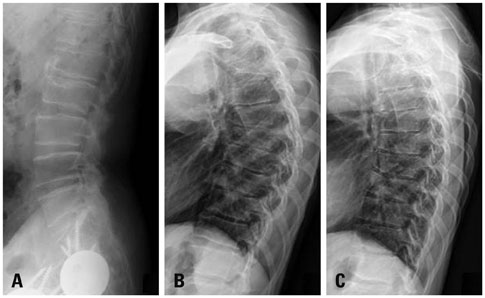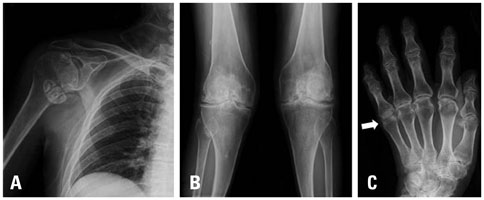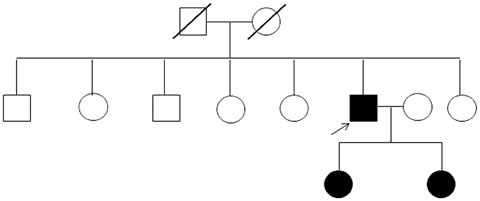Yonsei Med J.
2016 Sep;57(5):1290-1293. 10.3349/ymj.2016.57.5.1290.
Three Cases of Spondyloepiphyseal Dysplasia Tarda in One Korean Family
- Affiliations
-
- 1Division of Rheumatology, Department of Internal Medicine, Seoul National University Bundang Hospital, Seongnam, Korea.
- 2Department of Internal Medicine, Seoul National University College of Medicine, Seoul, Korea. ysong@snu.ac.kr
- 3Department of Molecular Medicine and Biopharmaceutical Sciences, Graduate School of Convergence Science and Technology, and College of Medicine, Seoul National University, Seoul, Korea.
- KMID: 2374179
- DOI: http://doi.org/10.3349/ymj.2016.57.5.1290
Abstract
- Spondyloepiphyseal dysplasia (SED) tarda is an inherited skeletal arthropathy. Because SED tarda involves the joints and resemble the clinical findings of chronic arthropathies, this disease is frequently misdiagnosed as juvenile idiopathic arthritis (JIA). We report here on three patients (father and his two daughters) in one family with SED tarda. All patients had back pain and polyarthralgia. Their radiographs revealed typical changes for SED tarda including platyspondyly and dysplastic bone changes. This rare disease has major clinical importance in that it is similar with JIA or rheumatoid arthritis.
MeSH Terms
Figure
Reference
-
1. Wynne-Davies R, Hall C, Ansell BM. Spondylo-epiphysial dysplasia tarda with progressive arthropathy. A "new" disorder of autosomal recessive inheritance. J Bone Joint Surg Br. 1982; 64:442–445.
Article2. Spranger J, Albert C, Schilling F, Bartsocas C, Stöss H. Progressive pseudorheumatoid arthritis of childhood (PPAC). A hereditary disorder simulating rheumatoid arthritis. Eur J Pediatr. 1983; 140:34–40.
Article3. Anderson IJ, Goldberg RB, Marion RW, Upholt WB, Tsipouras P. Spondyloepiphyseal dysplasia congenita: genetic linkage to type II collagen (COL2AI). Am J Hum Genet. 1990; 46:896–901.4. Leroy JG, Leroy BP, Emmery LV, Messiaen L, Spranger JW. A new type of autosomal recessive spondyloepiphyseal dysplasia tarda. Am J Med Genet A. 2004; 125A:49–56.
Article5. Kaptanoqlu E, Percin F, Percin S, Torel-Ergur A. Spondyloepiphyseal dysplasia tarda with progressive arthropathy. Turk J Pediatr. 2004; 46:380–383.6. Williams CJ, Considine EL, Knowlton RG, Reginato A, Neumann G, Harrison D, et al. Spondyloepiphyseal dysplasia and precocious osteoarthritis in a family with an Arg75-->Cys mutation in the procollagen type II gene (COL2A1). Hum Genet. 1993; 92:499–505.
Article7. Gedeon AK, Colley A, Jamieson R, Thompson EM, Rogers J, Sillence D, et al. Identification of the gene (SEDL) causing X-linked spondyloepiphyseal dysplasia tarda. Nat Genet. 1999; 22:400–404.
Article8. Barrowman J, Sacher M, Ferro-Novick S. TRAPP stably associates with the Golgi and is required for vesicle docking. EMBO J. 2000; 19:862–869.
Article9. Lowe M. Membrane transport: tethers and TRAPPs. Curr Biol. 2000; 10:R407–R409.
Article10. Venditti R, Scanu T, Santoro M, Di Tullio G, Spaar A, Gaibisso R, et al. Sedlin controls the ER export of procollagen by regulating the Sar1 cycle. Science. 2012; 337:1668–1672.
Article11. Yue H, Zhang ZL, He JW. Identification of novel mutations in WISP3 gene in two unrelated Chinese families with progressive pseudorheumatoid dysplasia. Bone. 2009; 44:547–554.
Article12. Sen M, Cheng YH, Goldring MB, Lotz MK, Carson DA. WISP3-dependent regulation of type II collagen and aggrecan production in chondrocytes. Arthritis Rheum. 2004; 50:488–497.
Article13. Oh IH, Song JS, Rim DH, Choi JW, Lee SH, Lee JH, et al. A case of spondyloepiphyseal dysplasia tarda misdiagnosed as ankylosing spondylitis. J Rheum Dis. 2011; 18:311–314.
Article14. Ryu H, Park J, Chae H, Kim M, Kim Y, Ok IY. X-linked spondyloepiphyseal dysplasia tarda: identification of a TRAPPC2 mutation in a Korean pedigree. Ann Lab Med. 2012; 32:234–237.
Article15. Kim HJ, Lee BH, Kim YM, Kim GH, Kim OH, Yoo HW. A case with spondylo-epiphyseal dysplasia tarda with TRAPPC2 mutation. J Genet Med. 2012; 9:31–34.
Article16. Bennani L, Amine B, Ichchou L, Lazrak N, Hajjaj-Hassouni N. Progressive pseudorheumatoid dysplasia: three cases in one family. Joint Bone Spine. 2007; 74:393–395.
Article
- Full Text Links
- Actions
-
Cited
- CITED
-
- Close
- Share
- Similar articles
-
- A Case with Spondyloepiphyseal Dysplasia Tarda with TRAPPC2 Mutation
- X-Linked Spondyloepiphyseal Dysplasia Tarda: Identification of a TRAPPC2 Mutation in a Korean Pedigree
- A Case of Spondyloepiphyseal Dysplasia Tarda (SEDT) Misdiagnosed as Ankylosing Spondylitis
- Diffuse Idiopathic Skeletal Hyperostosis and Thoracic Myelopathy in Spondyloepiphyseal Dysplasia Congenita: A Case Report
- A Case of Spondyloepiphyseal Dysplasia Congenita




